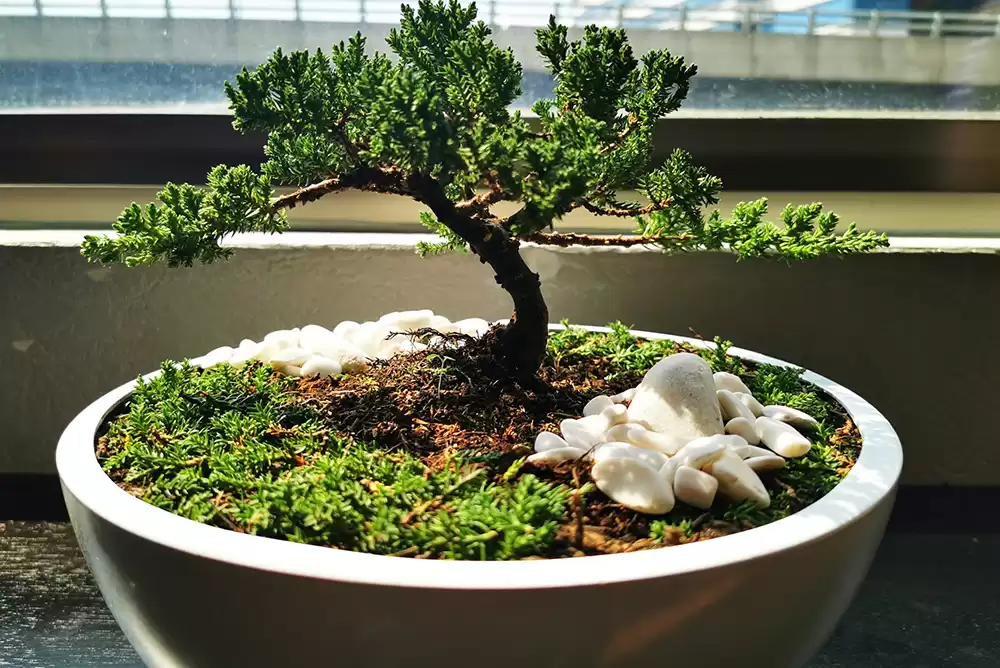
01 Mar How to Care for a Shimpaku Juniper Bonsai Tree
The Shimpaku Juniper Bonsai tree is a delicate and exquisite addition to any Japanese-themed garden or Koi pond. Proper maintenance of these bonsai trees requires attention to detail and expertise, which is why we emphasize the importance of entrusting their care to professional bonsai maintenance experts.
Selecting the Right Shimpaku Juniper Bonsai
When selecting a Shimpaku Juniper Bonsai, choosing a specimen with a well-defined trunk, healthy foliage, and a compact root system is crucial. Look for a tree that reflects the desired aesthetic for your garden or pond area.
Placement and Sunlight Requirements
These bonsai trees thrive in full sunlight, preferably receiving at least six hours of direct sunlight daily. However, they can also tolerate partial shade, especially during the hottest parts of the day. When setting up your Shimpaku Juniper Bonsai, ensure it has adequate airflow to prevent fungal issues.
Watering Techniques and Frequency
Proper watering is essential for the health of your Shimpaku Juniper Bonsai. Water thoroughly until water runs out of the drainage holes, ensuring the entire root system is moistened. Allow the soil to dry slightly between waterings to prevent root rot. Watering frequency will depend on factors such as temperature, humidity, and soil drainage.
Soil Composition and Repotting Schedule
A well-draining soil mix is crucial for Shimpaku Juniper Bonsai trees. Opt for a mix of akadama, pumice, and lava rock to promote proper drainage and aeration. Repotting should be done every two to three years in early spring before new growth begins. This allows for root pruning and replenishing of nutrients in the soil.
Pruning and Shaping the Bonsai
Regular pruning is necessary to maintain the desired shape and size of your Shimpaku Juniper Bonsai. Use sharp, clean tools to remove dead or overgrown branches, maintaining balance and symmetry. Shaping can be done through wiring, but care must be taken to avoid damaging the delicate branches.
Pest and Disease Management
Keep a close eye on your bonsai for signs of pests or diseases, such as spider mites, aphids, or fungal infections. Treat infestations promptly with organic pesticides or fungicides and ensure proper cultural practices to prevent future issues.
Incorporating the Bonsai into Japanese-themed Gardens
Shimpaku Juniper Bonsai trees add a sense of tranquility and elegance to Japanese-themed gardens or Koi ponds. Consider incorporating them as focal points or accents within your garden design, complementing other elements such as rocks, lanterns, and water features.
Enhancing Visual Appeal with Professional Bonsai Maintenance
For homeowners or business owners in Los Angeles seeking to enhance the visual appeal of their outdoor spaces, professional bonsai maintenance services can ensure the health and beauty of their Shimpaku Juniper Bonsai trees. Our experts at Aquatic Gardens are skilled in the art of bonsai care, providing tailored maintenance plans to suit your specific needs and preferences.
In conclusion, caring for a Shimpaku Juniper Bonsai requires a combination of technical knowledge and attentive care. By following proper guidelines for selection, placement, watering, soil composition, pruning, pest management, and professional maintenance, you can enjoy the timeless beauty of these exquisite bonsai trees in your Japanese-themed garden or Koi pond area. Trust Aquatic Gardens to help you maintain the health and vitality of your Shimpaku Juniper Bonsai for years to come.



